1 of 16
Download to read offline
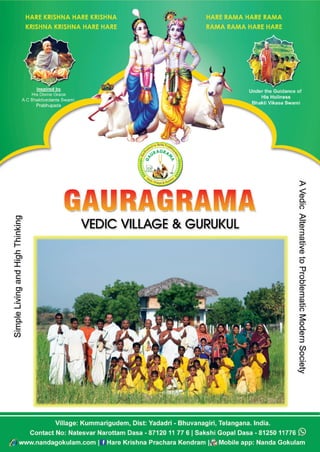
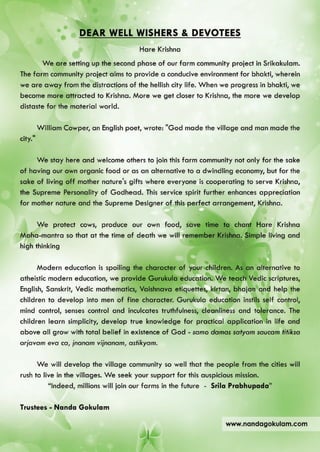

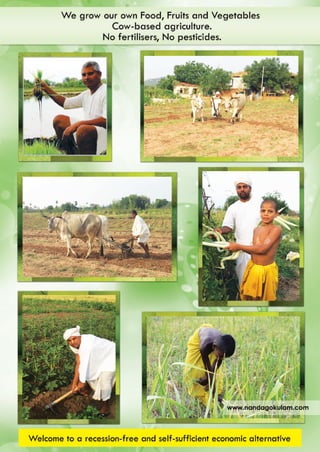
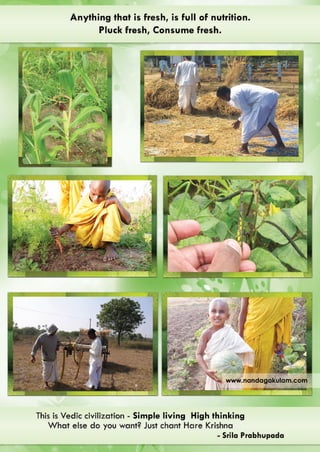
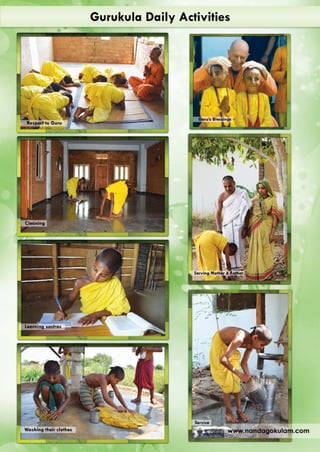
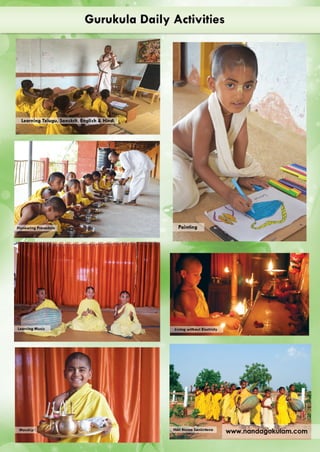
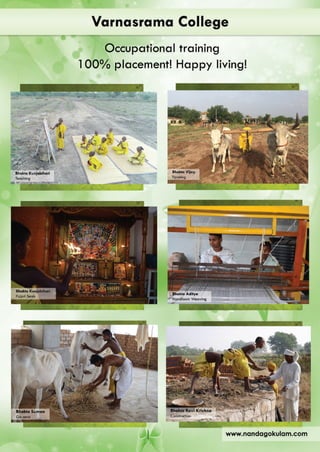
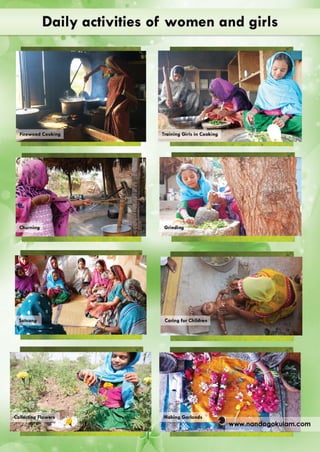
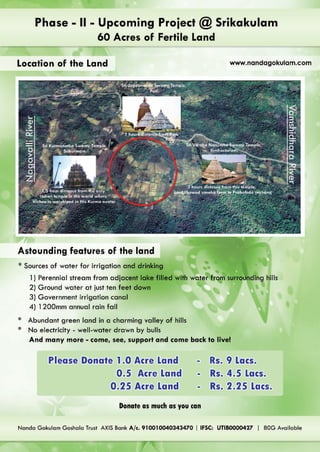
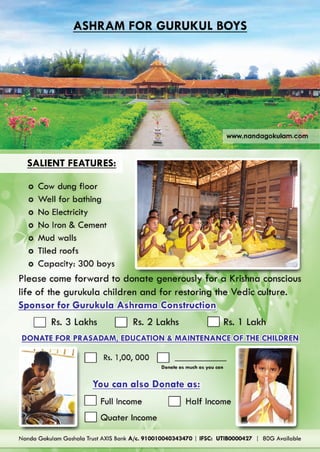

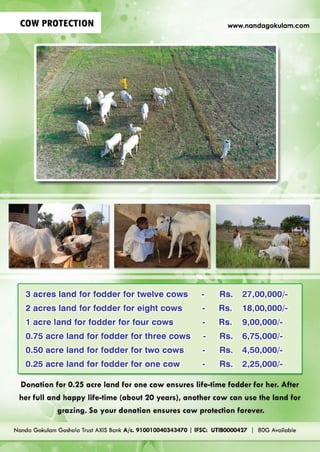


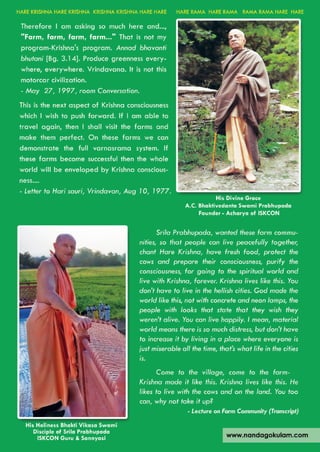
Ad
Recommended
Vedic eco village western canada development plan 2017 26
Vedic eco village western canada development plan 2017 26 SriSurabhi
╠²
The Western Canada Development Plan outlines the establishment and growth of the Vedic Eco Village, aimed at creating a sustainable community based on Vedic principles such as farming, cow care, and education. The plan includes details on its mission, target audience, activities, budget, and timeline from 2017 to 2026, highlighting ongoing projects like guest facilities and a cow sanctuary. The initiative seeks to attract participants and volunteers to foster a self-sufficient lifestyle while preserving traditional values and practices.Idvm --nandagram
Idvm --nandagramSriSurabhi
╠²
Nandagram Vedic Village is a community located 10 km from the Statue of Unity and 100 km from Baroda, Gujarat. It is dedicated to spiritual leaders Sri Sri Gauranga and A.C. Bhaktivedanta Swami Prabhupada and guided by Bhakti Vikasa Swami. The community has 21 families and 85 devotees living a simple, agrarian lifestyle focused on farming, weaving, construction and spiritual activities like deity worship. The village aims to provide training to boys in the Gurukula in accordance with their natures without modern or government education.The global importance_of_cow_protection
The global importance_of_cow_protectionSriSurabhi
╠²
The document discusses the global significance of cow protection, emphasizing the ethical and economic reasons against killing cows for meat, advocating instead for their roles in agriculture and energy production. It critiques industrial dairy practices, highlighting the negative impacts on animal welfare, milk quality, and consumer health, while promoting the benefits of raw milk and alternative uses for cow by-products. The text ultimately argues that cows are more valuable alive for their contributions and the nutrients they provide.Bhagavata mahavidyalaya presentation
Bhagavata mahavidyalaya presentationSriSurabhi
╠²
ISKCON Bhagavata Mahavidyalaya is a university established in 2014 that focuses on Vedic studies through various programs on the Srimad Bhagavatam and Chaitanya Charitamrita. The university aims to provide free Vedic education in an environment appropriate to the Vaisnava tradition. Students in the 3-year residential program will learn from the writings of Srila Prabhupada as well as Sanskrit, philosophy, and commentaries from previous acharyas. The university operates on a budget of 27 lakh rupees annually and requests donations to support its free educational initiatives.Amsu
AmsuSriSurabhi
╠²
Amsu began in 2016 with 2 farmers, 5 cows, and 6 acres of land in India. They cultivate non-GMO cotton using cow-based agriculture and employ local women to hand spin the cotton into yarn using traditional tools. Local weavers then weave the yarn and the fabrics are dyed with plant-based dyes. The resulting textiles are made into shirts, kurtas and jackets. Currently, Amsu works with 5 farmers with 16 acres of land and 18 cows across 3 villages in India. Their products address issues like farmer suicides, unemployed weavers, and toxic chemicals in clothes while preserving natural resources and cultural heritage.Om sri-surabhi-campaign-global
Om sri-surabhi-campaign-globalSriSurabhi
╠²
The Om Shri Surabhi Campaign is a 12-year global initiative to promote cow protection and an agrarian Vedic culture. It aims to protect all life, especially cows, through traditional education, sustainable living, and the teachings of the Bhagavad Gita and Srimad Bhagavatam. Short term goals include individuals taking a cow protection pledge, using cow products at home, and temples promoting healthy living. Long term objectives involve governments recognizing cows and adopting more sustainable agricultural practices. The campaign is a joint effort between organizations in multiple countries.Pasraman Sandipani Muni
Pasraman Sandipani MuniSriSurabhi
╠²
This document provides information about Pasraman Sandipani Muni, a spiritual community located in Lampung, Indonesia. It lists the founder, address, and contact information. It then outlines some of the community's daily activities, which include Bhagavad-Gita classes, worship of the cows, tending to the cows and agriculture, making offerings, and recreational activities like archery and swimming. The overall purpose of the community seems to be spiritual practices centered around caring for cows and farming.Varnasrama krishna-consciousness-part-3
Varnasrama krishna-consciousness-part-3SriSurabhi
╠²
1) The document outlines Srila Prabhupada's four phase preaching blueprint for developing Krishna conscious communities.
2) The four phases are: prior preparation, occupying and settling the land, developing the community, and preaching.
3) Prior preparation involves raising awareness, education, acquiring land and other resources. Occupying the land involves developing basic infrastructure like housing, water sources, and agriculture.
4) Developing the community involves establishing regular spiritual practices, expanding facilities, raising funds, and increasing population. The goal is self-sufficiency and less dependence on outside resources.Varnasrama krishna-consciousness-part-2
Varnasrama krishna-consciousness-part-2SriSurabhi
╠²
This document summarizes a seminar on Varnashrama and Krishna consciousness presented by Hari Kirtan das. It discusses the different varnas (Brahmana, Kshatriya, Vaishya, Shudra) based on guna and karma. It then describes the different ashramas (Brahmacharya, Grihastha, Vanaprastha, Sannyasa) and their duties. It also discusses women's roles and responsibilities within Varnashrama. Finally, it provides the example of Srila Madhavendra Puri to illustrate how advanced devotees can transcend the rules and rituals of Varnashrama by fully engaging in KrishnaVarnasrama & Krishna Consciousness
Varnasrama & Krishna ConsciousnessSriSurabhi
╠²
This document provides an overview of an upcoming seminar on Varnashrama and Krishna Consciousness. The seminar will be presented in two parts. Part I will introduce Varnashrama Dharma, discuss its purpose and types based on scriptural references. It will cover perspectives on Varnashrama from major Acharyas and its historical practice in the four Yugas. Part II will focus on applying Varnashrama Dharma in ISKCON communities through practices like farming communities and gurukulas.Ils 2018 varnasrama without gurukula - just a hobby
Ils 2018 varnasrama without gurukula - just a hobbySriSurabhi
╠²
The document discusses the importance of establishing a varnashrama system with guru-kulas and varnashrama colleges according to Srila Prabhupada. It provides quotes emphasizing that guru-kulas, where young boys are trained from ages 5-10, and varnashrama colleges are essential for a society to properly function. However, attempts to establish these in ISKCON did not succeed due to lack of funding, qualified teachers, and commitment from members. Modern education is criticized as producing "dogs" and "fools" instead of independently minded brahmanas, ksatriyas, and vaishyas.Power point varnasrama-a-culture-sept-2017
Power point varnasrama-a-culture-sept-2017SriSurabhi
╠²
1. Varnasrama provides social guidance that enables a person to achieve the goal of life - pure devotion.
2. These recommendations consist of main rules and secondary rules.
3. The main rules are solid, while the secondary rules are valid under certain conditions and can be adapted based on time, place, and circumstances.4 th wave_presentation_lates
4 th wave_presentation_latesSriSurabhi
╠²
This document outlines a 4-wave movement to fulfill Srila Prabhupada's mission and spread the teachings of Lord Chaitanya. The 1st wave focused on sankirtan and distributing books, the 2nd on establishing temples, the 3rd on youth meetings and spiritual initiation, and the 4th wave is on varnashrama dharma. It then describes a proposed 10.6 acre project donating land for an ISKCON facility, residences, and organic farming utilizing rain water harvesting and solar energy. The development will occur in stages to establish this service to the community without ownership of the land.Mother farm year-end_review
Mother farm year-end_reviewSriSurabhi
╠²
The Mother Farm had a productive year in 2017, with activities focused on cow protection including operating a goshala with 45 cows and 9 calves. The farm produces dairy products for distribution and the milk is also delivered regularly to a temple. The farm offers preaching programs to spread Krishna consciousness and held its fourth annual village festival. It is establishing partnerships within Ukraine to further the cause of cow protection and distributed its dairy products and books at an international festival. The farm aims to motivate devotees to live rurally and protect cows.Vasusresthas ppt varna_asr
Vasusresthas ppt varna_asrSriSurabhi
╠²
Varnashrama is the natural social structure according to Vedic principles. It divides society according to four varnas (brahmana, ksatriya, vaishya, sudra) and four ashramas (brahmacari, grhastha, vanaprastha, sannyasa). New Govardhana farm in Australia is implementing varnashrama principles through departments like the temple, goshala, school, eco-village, and guest houses. It generates income through various programs and aims to reduce mechanization. ISKCON Lithuania is also implementing varnashrama through farms like Govardhana, Gokul, and a brahmacari farm.Varnasrama Research Team
Varnasrama Research TeamSriSurabhi
╠²
This document outlines the establishment of Varnasrama Research Teams (VRT) to support the global mission of implementing a varnasrama society. VRTs would bring together interested individuals as a team to research and develop knowledge and skills related to traditional occupations. These include areas like organic farming, cow protection, rural development, and village technologies. The teams would work to educate others on varnasrama dharma and support local farm projects through sharing their research findings, visiting experts, and acquiring resources to help materialize Srila Prabhupada's vision.Varnasrama Education - part 2
Varnasrama Education - part 2SriSurabhi
╠²
This document provides an overview of the Varnasrama education system based on teachings from the Vedic texts. It describes how education is tailored based on a student's natural aptitudes and vocational interests. Students may receive either formal education in a Gurukula focusing on religious texts or non-formal apprenticeship training. Education is also phased according to one's stage of life, known as Asramas. The goal is to spiritually elevate students and guide them towards perfection through a lifelong learning process focused on service, inquiry and surrender.Cow protection - quotes by famous personalities
Cow protection - quotes by famous personalitiesSriSurabhi
╠²
This document contains quotes from religious and political leaders on the importance of cow protection. It includes quotes from sources like the Bhagavad Gita, Jesus Christ, the Quran, Lord Buddha, Guru Govind Singh, M.K. Gandhi, former presidents of India, and others stressing that killing cows is sinful and against religious teachings. The quotes emphasize the spiritual, economic, and social significance of cows and highlight their role in providing sustenance and prosperity to people.Paper money and its flaws
Paper money and its flawsSriSurabhi
╠²
The document discusses the flaws of paper currency as money. It defines different types of money including commodity money, which derives value from the commodity it represents like gold, and fiat money, which derives value from government regulation alone. Paper currency is considered fiat money. The document discusses how governments debase currency through practices like removing commodity backing and excessive money printing, which can lead to inflation. Srila Prabhupada is quoted explaining that paper currency is worthless in times of crisis while commodities like grains and cows retain value. He advocates for producing one's own food rather than relying on paper money.Position paper of ISKCON leadership in India
Position paper of ISKCON leadership in IndiaSriSurabhi
╠²
This document outlines ISKCON's position on leadership and promoting rural development in India. It discusses Srila Prabhupada's founding mission of the four movements including Sankirtan, temple worship, spiritual initiation, and creating a classless society. It also notes Srila Prabhupada's instructions to establish self-sufficient Krishna conscious communities and villages. The document endorses the ISKCON Daiva Varnasrama Ministry in India which was established to promote rural development through programs like establishing Krishna conscious rural communities and helping existing villages become self-sufficient.Killing the Higher Principles of Life
Killing the Higher Principles of LifeSriSurabhi
╠²
The document discusses the importance of introducing Varnasrama Dharma to avoid killing higher principles of life. It states that both liberated and conditioned souls follow Varnasrama Dharma as duties according to one's Varna are favorable for devotional service. The founder Acharya advised establishing rural communities where people grow their own food to be self-sufficient and concentrate on farm projects. Golden rules include producing only what is needed, agriculture as the norm, education as a privilege, and following an agrarian not urban lifestyle.City life and Cow protection
City life and Cow protectionSriSurabhi
╠²
This document discusses ways to honor and protect cows. It recommends taking a lifelong pledge to protect cows, adopting or supporting cows at goshalas, using panchgavya products, avoiding cow slaughter-derived medicines and leather, using organic fertilizers and pesticides, and helping cows in danger. It also suggests promoting cow protection through religious institutions, governments, and international organizations. The author is involved in ISKCON and cow protection efforts.Varnasrama Education
Varnasrama EducationSriSurabhi
╠²
This document discusses the concept of education according to Vedic philosophy. It defines education as cultivating knowledge about reality, both spiritual and physical. Education occurs on five levels of consciousness and aims to develop the body, mind, and spirit. Formal education takes place in gurukulas, while non-formal and informal education occur through other means. The Vedic system sees education as a lifelong process of self-realization according to one's stage of life and social role.Brahmacari
BrahmacariSriSurabhi
╠²
This document discusses the importance of brahmacarya or celibacy. It defines brahmacarya as complete abstinence from sex in work, words, and mind at all times. Practicing brahmacarya from a young age helps one control the senses and develop a firm friendship with the spiritual master. It lists the 8 aspects to avoid for one observing brahmacarya. It contrasts the lives of those practicing brahmacarya versus grihamedhis who are fully engaged in sense gratification. Maintaining brahmacarya increases qualities like strength and knowledge, while attachment to women brings great suffering. In conclusion, brahmacarya is essential for spiritual life as it helps one become detached from sex lifeChanakya Niti - Chapter 01
Chanakya Niti - Chapter 01SriSurabhi
╠²
This document provides an introduction and first chapter of the Sri Chanakya Niti text. It begins with introductory prayers and outlines the benefits of studying niti-shastra scriptures for understanding dharma. The chapter then provides several maxims, including that maintaining a wicked wife or associating with the wretched can harm even learned people. It advises saving money for hard times, protecting one's wife and wealth, but saving one's soul above all. Friends and relatives should be tested in times of difficulty or misfortune to determine who is truly loyal. Marriage, trust, and where one lives are also discussed. The chapter ends by stating women have twice the hunger and lust of men.Water Cycle
Water CycleSriSurabhi
╠²
The water cycle document describes the natural circulation of water on Earth. It explains that water evaporates from soil, plants and bodies of water before condensing in the atmosphere and falling as precipitation. Some precipitation soaks into the soil to be used by plants and replenish groundwater, while excess runs off into streams, rivers and lakes eventually making its way to the sea. An effective water cycle is important to decrease floods and droughts and depends on maintaining soil cover and organic matter.Joshua Through the Lens of Jesus: Part 2 - Ch.4-6
Joshua Through the Lens of Jesus: Part 2 - Ch.4-6Vintage Church
╠²
Joshua Through the Lens of Jesus: Part 2 - Ch.4-6More Related Content
More from SriSurabhi (20)
Varnasrama krishna-consciousness-part-2
Varnasrama krishna-consciousness-part-2SriSurabhi
╠²
This document summarizes a seminar on Varnashrama and Krishna consciousness presented by Hari Kirtan das. It discusses the different varnas (Brahmana, Kshatriya, Vaishya, Shudra) based on guna and karma. It then describes the different ashramas (Brahmacharya, Grihastha, Vanaprastha, Sannyasa) and their duties. It also discusses women's roles and responsibilities within Varnashrama. Finally, it provides the example of Srila Madhavendra Puri to illustrate how advanced devotees can transcend the rules and rituals of Varnashrama by fully engaging in KrishnaVarnasrama & Krishna Consciousness
Varnasrama & Krishna ConsciousnessSriSurabhi
╠²
This document provides an overview of an upcoming seminar on Varnashrama and Krishna Consciousness. The seminar will be presented in two parts. Part I will introduce Varnashrama Dharma, discuss its purpose and types based on scriptural references. It will cover perspectives on Varnashrama from major Acharyas and its historical practice in the four Yugas. Part II will focus on applying Varnashrama Dharma in ISKCON communities through practices like farming communities and gurukulas.Ils 2018 varnasrama without gurukula - just a hobby
Ils 2018 varnasrama without gurukula - just a hobbySriSurabhi
╠²
The document discusses the importance of establishing a varnashrama system with guru-kulas and varnashrama colleges according to Srila Prabhupada. It provides quotes emphasizing that guru-kulas, where young boys are trained from ages 5-10, and varnashrama colleges are essential for a society to properly function. However, attempts to establish these in ISKCON did not succeed due to lack of funding, qualified teachers, and commitment from members. Modern education is criticized as producing "dogs" and "fools" instead of independently minded brahmanas, ksatriyas, and vaishyas.Power point varnasrama-a-culture-sept-2017
Power point varnasrama-a-culture-sept-2017SriSurabhi
╠²
1. Varnasrama provides social guidance that enables a person to achieve the goal of life - pure devotion.
2. These recommendations consist of main rules and secondary rules.
3. The main rules are solid, while the secondary rules are valid under certain conditions and can be adapted based on time, place, and circumstances.4 th wave_presentation_lates
4 th wave_presentation_latesSriSurabhi
╠²
This document outlines a 4-wave movement to fulfill Srila Prabhupada's mission and spread the teachings of Lord Chaitanya. The 1st wave focused on sankirtan and distributing books, the 2nd on establishing temples, the 3rd on youth meetings and spiritual initiation, and the 4th wave is on varnashrama dharma. It then describes a proposed 10.6 acre project donating land for an ISKCON facility, residences, and organic farming utilizing rain water harvesting and solar energy. The development will occur in stages to establish this service to the community without ownership of the land.Mother farm year-end_review
Mother farm year-end_reviewSriSurabhi
╠²
The Mother Farm had a productive year in 2017, with activities focused on cow protection including operating a goshala with 45 cows and 9 calves. The farm produces dairy products for distribution and the milk is also delivered regularly to a temple. The farm offers preaching programs to spread Krishna consciousness and held its fourth annual village festival. It is establishing partnerships within Ukraine to further the cause of cow protection and distributed its dairy products and books at an international festival. The farm aims to motivate devotees to live rurally and protect cows.Vasusresthas ppt varna_asr
Vasusresthas ppt varna_asrSriSurabhi
╠²
Varnashrama is the natural social structure according to Vedic principles. It divides society according to four varnas (brahmana, ksatriya, vaishya, sudra) and four ashramas (brahmacari, grhastha, vanaprastha, sannyasa). New Govardhana farm in Australia is implementing varnashrama principles through departments like the temple, goshala, school, eco-village, and guest houses. It generates income through various programs and aims to reduce mechanization. ISKCON Lithuania is also implementing varnashrama through farms like Govardhana, Gokul, and a brahmacari farm.Varnasrama Research Team
Varnasrama Research TeamSriSurabhi
╠²
This document outlines the establishment of Varnasrama Research Teams (VRT) to support the global mission of implementing a varnasrama society. VRTs would bring together interested individuals as a team to research and develop knowledge and skills related to traditional occupations. These include areas like organic farming, cow protection, rural development, and village technologies. The teams would work to educate others on varnasrama dharma and support local farm projects through sharing their research findings, visiting experts, and acquiring resources to help materialize Srila Prabhupada's vision.Varnasrama Education - part 2
Varnasrama Education - part 2SriSurabhi
╠²
This document provides an overview of the Varnasrama education system based on teachings from the Vedic texts. It describes how education is tailored based on a student's natural aptitudes and vocational interests. Students may receive either formal education in a Gurukula focusing on religious texts or non-formal apprenticeship training. Education is also phased according to one's stage of life, known as Asramas. The goal is to spiritually elevate students and guide them towards perfection through a lifelong learning process focused on service, inquiry and surrender.Cow protection - quotes by famous personalities
Cow protection - quotes by famous personalitiesSriSurabhi
╠²
This document contains quotes from religious and political leaders on the importance of cow protection. It includes quotes from sources like the Bhagavad Gita, Jesus Christ, the Quran, Lord Buddha, Guru Govind Singh, M.K. Gandhi, former presidents of India, and others stressing that killing cows is sinful and against religious teachings. The quotes emphasize the spiritual, economic, and social significance of cows and highlight their role in providing sustenance and prosperity to people.Paper money and its flaws
Paper money and its flawsSriSurabhi
╠²
The document discusses the flaws of paper currency as money. It defines different types of money including commodity money, which derives value from the commodity it represents like gold, and fiat money, which derives value from government regulation alone. Paper currency is considered fiat money. The document discusses how governments debase currency through practices like removing commodity backing and excessive money printing, which can lead to inflation. Srila Prabhupada is quoted explaining that paper currency is worthless in times of crisis while commodities like grains and cows retain value. He advocates for producing one's own food rather than relying on paper money.Position paper of ISKCON leadership in India
Position paper of ISKCON leadership in IndiaSriSurabhi
╠²
This document outlines ISKCON's position on leadership and promoting rural development in India. It discusses Srila Prabhupada's founding mission of the four movements including Sankirtan, temple worship, spiritual initiation, and creating a classless society. It also notes Srila Prabhupada's instructions to establish self-sufficient Krishna conscious communities and villages. The document endorses the ISKCON Daiva Varnasrama Ministry in India which was established to promote rural development through programs like establishing Krishna conscious rural communities and helping existing villages become self-sufficient.Killing the Higher Principles of Life
Killing the Higher Principles of LifeSriSurabhi
╠²
The document discusses the importance of introducing Varnasrama Dharma to avoid killing higher principles of life. It states that both liberated and conditioned souls follow Varnasrama Dharma as duties according to one's Varna are favorable for devotional service. The founder Acharya advised establishing rural communities where people grow their own food to be self-sufficient and concentrate on farm projects. Golden rules include producing only what is needed, agriculture as the norm, education as a privilege, and following an agrarian not urban lifestyle.City life and Cow protection
City life and Cow protectionSriSurabhi
╠²
This document discusses ways to honor and protect cows. It recommends taking a lifelong pledge to protect cows, adopting or supporting cows at goshalas, using panchgavya products, avoiding cow slaughter-derived medicines and leather, using organic fertilizers and pesticides, and helping cows in danger. It also suggests promoting cow protection through religious institutions, governments, and international organizations. The author is involved in ISKCON and cow protection efforts.Varnasrama Education
Varnasrama EducationSriSurabhi
╠²
This document discusses the concept of education according to Vedic philosophy. It defines education as cultivating knowledge about reality, both spiritual and physical. Education occurs on five levels of consciousness and aims to develop the body, mind, and spirit. Formal education takes place in gurukulas, while non-formal and informal education occur through other means. The Vedic system sees education as a lifelong process of self-realization according to one's stage of life and social role.Brahmacari
BrahmacariSriSurabhi
╠²
This document discusses the importance of brahmacarya or celibacy. It defines brahmacarya as complete abstinence from sex in work, words, and mind at all times. Practicing brahmacarya from a young age helps one control the senses and develop a firm friendship with the spiritual master. It lists the 8 aspects to avoid for one observing brahmacarya. It contrasts the lives of those practicing brahmacarya versus grihamedhis who are fully engaged in sense gratification. Maintaining brahmacarya increases qualities like strength and knowledge, while attachment to women brings great suffering. In conclusion, brahmacarya is essential for spiritual life as it helps one become detached from sex lifeChanakya Niti - Chapter 01
Chanakya Niti - Chapter 01SriSurabhi
╠²
This document provides an introduction and first chapter of the Sri Chanakya Niti text. It begins with introductory prayers and outlines the benefits of studying niti-shastra scriptures for understanding dharma. The chapter then provides several maxims, including that maintaining a wicked wife or associating with the wretched can harm even learned people. It advises saving money for hard times, protecting one's wife and wealth, but saving one's soul above all. Friends and relatives should be tested in times of difficulty or misfortune to determine who is truly loyal. Marriage, trust, and where one lives are also discussed. The chapter ends by stating women have twice the hunger and lust of men.Water Cycle
Water CycleSriSurabhi
╠²
The water cycle document describes the natural circulation of water on Earth. It explains that water evaporates from soil, plants and bodies of water before condensing in the atmosphere and falling as precipitation. Some precipitation soaks into the soil to be used by plants and replenish groundwater, while excess runs off into streams, rivers and lakes eventually making its way to the sea. An effective water cycle is important to decrease floods and droughts and depends on maintaining soil cover and organic matter.Recently uploaded (20)
Joshua Through the Lens of Jesus: Part 2 - Ch.4-6
Joshua Through the Lens of Jesus: Part 2 - Ch.4-6Vintage Church
╠²
Joshua Through the Lens of Jesus: Part 2 - Ch.4-6Kaia Ra Sedona - A Global Spiritual Leader
Kaia Ra Sedona - A Global Spiritual LeaderKaia Ra Sedona
╠²
Kaia Ra's extraordinary travels to energetically charged spaces such as Sedona complement her gifts as an oracle and have propelled her to the forefront of spiritual leadership. Her work, centered around The Sophia Code, incorporates teachings from celestial realms and the Ascended Masters. NKo (▀Æ▀×▀Å) - The Importance of Child Discipline and Honoring Your Parents - ▀ś▀ŗ...
NKo (▀Æ▀×▀Å) - The Importance of Child Discipline and Honoring Your Parents - ▀ś▀ŗ...Filipino Tracts and Literature Society Inc.
╠²
Train up a child in the way he should go: and when he is old, he will not depart from it. Proverbs 22:6 Children, obey your parents in the Lord: for this is right. Honour thy father and mother; which is the first commandment with promise; That it may be well with thee, and thou mayest live long on the earth. Ephesians 6:1-3 Honour thy father with thy whole heart, and forget not the sorrows of thy mother. Remember that thou wast begotten of them; and how canst thou recompense them the things that they have done for thee? Ecclesiasticus 7:27-28Monthly Khazina-e-Ruhaniyaat JunŌĆÖ2025 (Vol.16, Issue 2)
Monthly Khazina-e-Ruhaniyaat JunŌĆÖ2025 (Vol.16, Issue 2)Darul Amal Chishtia
╠²
2nd issue of Volume 16. A magazine in urdu language mainly based on spiritual treatment and learning. Many topics on ISLAM, SUFISM, SOCIAL PROBLEMS, SELF HELP, PSYCHOLOGY, HEALTH, SPIRITUAL TREATMENT, Ruqya etc. A very useful magazine for everyone.Vincentian Marian Youth - History, Identity and Activities
Vincentian Marian Youth - History, Identity and ActivitiesFamvin: the Worldwide Vincentian Family
╠²
Vincentian Marian Youth - History, Identity and Activities. from their International website jmvinter.orgPangasinan - The Importance of Child Discipline and Honoring Your Parents - K...
Pangasinan - The Importance of Child Discipline and Honoring Your Parents - K...Filipino Tracts and Literature Society Inc.
╠²
Train up a child in the way he should go: and when he is old, he will not depart from it. Proverbs 22:6 Children, obey your parents in the Lord: for this is right. Honour thy father and mother; which is the first commandment with promise; That it may be well with thee, and thou mayest live long on the earth. Ephesians 6:1-3 Honour thy father with thy whole heart, and forget not the sorrows of thy mother. Remember that thou wast begotten of them; and how canst thou recompense them the things that they have done for thee? Ecclesiasticus 7:27-28Manifestation Mastery Essential 1st Edition.pdf
Manifestation Mastery Essential 1st Edition.pdfInfinite Abundance Information Systems
╠²
Manifestation Mastery Essential Affirmations are a compilation of the most powerful declarations in the public sphere.
The first edition features 253 highly-effective affirmations you can use to shift reality toward your desired outcomes.
This document was created by Pastor CW Johnson (PCWJ2030). Spiritual Healing and Chakra Balancing.pdf
Spiritual Healing and Chakra Balancing.pdfnavnidhi0101
╠²
In today's fast-paced and highly digital world, stress has become an inseparable part of life. From children burdened with academic competition to working professionals juggling personal and professional responsibilities, the need for inner peace and emotional balance has never been greater. One of the most profound and time-tested solutions to this crisis lies in spiritual healingŌĆöan ancient practice rooted in energy alignment, chakra balancing, and Kundalini awakening.Isis Monteverde - Balinese Culture, Arts and Wildlife
Isis Monteverde - Balinese Culture, Arts and Wildlifeisis Monteverde
╠²
Balinese culture and arts are heavily influenced by the religious aspects of the island, offering a wonderful opportunity to truly immerse oneself in the culture. Some of the best-known practises outside of Bali are the traditional Balinese dances, which are performed to connect with the gods.Presentation_The Seven Spiritual Laws Of Success.pptx
Presentation_The Seven Spiritual Laws Of Success.pptxLokesh Thegreat
╠²
The Seven Spiritual Laws Of SuccessPunjabi Shahmukhi ┘Š┘åž¼ž¦ž©█ī ž┤ž¦█ü ┘ģ┌®┌Š█ī - The Importance of Child Discipline and Ho...
Punjabi Shahmukhi ┘Š┘åž¼ž¦ž©█ī ž┤ž¦█ü ┘ģ┌®┌Š█ī - The Importance of Child Discipline and Ho...Filipino Tracts and Literature Society Inc.
╠²
Train up a child in the way he should go: and when he is old, he will not depart from it. Proverbs 22:6 Children, obey your parents in the Lord: for this is right. Honour thy father and mother; which is the first commandment with promise; That it may be well with thee, and thou mayest live long on the earth. Ephesians 6:1-3 Honour thy father with thy whole heart, and forget not the sorrows of thy mother. Remember that thou wast begotten of them; and how canst thou recompense them the things that they have done for thee? Ecclesiasticus 7:27-28Level of Abstraction- to understand the texts and their meaning from an islam...
Level of Abstraction- to understand the texts and their meaning from an islam...MdArifulIslamApu
╠²
To understand the way to find the meaning of an Islamic text (scripture).English - Prisoners of Hope - To open the blind eyes, to bring out the prison...
English - Prisoners of Hope - To open the blind eyes, to bring out the prison...Filipino Tracts and Literature Society Inc.
╠²
Thus saith God the LORD, he that created the heavens, and stretched them out; he that spread forth the earth, and that which cometh out of it; he that giveth breath unto the people upon it, and spirit to them that walk therein: I the LORD have called thee in righteousness, and will hold thine hand, and will keep thee, and give thee for a covenant of the people, for a light of the Gentiles; To open the blind eyes, to bring out the prisoners from the prison, and them that sit in darkness out of the prison house. Isaiah 42:5-7Everything You Need to Know Before Visiting Pashupatinath Temple.docx
Everything You Need to Know Before Visiting Pashupatinath Temple.docxJeneliaDC
╠²
Historical Significance of Pashupatinath Temple
Pashupatinath Temple is one of Nepal's oldest and most sacred Hindu temples, dating back to the 5th century CE. Located in the capital city of Kathmandu, just 2 kilometers (a 7-minute drive) from Tribhuvan International Airport, it has long served as a spiritual heart for devotees of Lord Shiva.
women in the ministryWhat do you do when you face these giants in life? How d...
women in the ministryWhat do you do when you face these giants in life? How d...MaamFranzRebadavia
╠²
In ministry, women have diverse roles focused on service, discipleship, and support, contributing to the church and community through various activities. While some denominations restrict women from certain leadership positions like pastor or elder, women actively participate in teaching, evangelism, prayer, worship, and service within the church. They also play a vital role in women's ministry, fostering spiritual growth, community, and outreach.
Here's a more detailed look:
General Roles:
Discipleship and Mentorship:
Women can mentor other women, teaching them about the Bible and helping them grow in their faith.
Service and Volunteering:
Women are encouraged to use their gifts to serve the church and community, whether through hospitality, event planning, or other practical needs.
Evangelism and Outreach:
Women can share their faith with others, invite people to church, and participate in outreach programs.
Spiritual Disciplines:
Women can lead in prayer, fasting, and Bible study, fostering a deeper relationship with God.
Support and Encouragement:
Women can provide emotional support to others, build up the church body, and encourage church leaders. What do you do when you face these giants in life? How do you face the giants in your life and work? Well, fortunately, we have a wonderful story in the
Specific Examples:
Women's Ministry:
Many churches have specific women's ministries that focus on creating a space for women to connect, learn, and grow together. These ministries often involve Bible studies, social events, and service projects.
Deaconesses:
Some churches have deaconesses who serve in various practical ways within the church, often focusing on ministry to women and families.
Influence on Church Leadership:
Women can have a powerful influence on church leaders, offering support, encouragement, and theological insights.
Biblical Examples:
The Bible offers examples of women who played important roles in ministry, such as Mary Magdalene, who was the first to witness the resurrection, and Lydia, who hosted the Apostle Paul.
Examples of Service:
Women can organize and lead Bible studies, mentor young women, participate in church leadership roles (depending on denomination), and reach out to the community through various service projects.
Key Considerations:
Denominational Differences:
Specific roles and opportunities for women in ministry can vary significantly depending on the denomination and its interpretation of biblical passages.
Gifts and Passions:
Women are encouraged to discover their unique gifts and passions and then use them to serve God and others.
Unity and Community:
Women's ministries can be powerful tools for building unity within the church, fostering positive relationships, and reaching out to the broader community. Facing giants in life and work refers to confronting significant challenges, obstacles, or fears that hinder personal growth, success, or well-being. These "giants" can manifest as personal stru5 Sets of LIFE Lessons to Live By ~ A Free eBook for Wise Living (pdf).pdf
5 Sets of LIFE Lessons to Live By ~ A Free eBook for Wise Living (pdf).pdfOH TEIK BIN
╠²
An important free eBook comprising 5 Presentations with Dhamma/Life Lessons/Educational Teachings to learn, reflect and practice in the quest to live a life of morality, happiness, peace and wisdom.
The texts are in English and Chinese.NKo (▀Æ▀×▀Å) - The Importance of Child Discipline and Honoring Your Parents - ▀ś▀ŗ...
NKo (▀Æ▀×▀Å) - The Importance of Child Discipline and Honoring Your Parents - ▀ś▀ŗ...Filipino Tracts and Literature Society Inc.
╠²
Pangasinan - The Importance of Child Discipline and Honoring Your Parents - K...
Pangasinan - The Importance of Child Discipline and Honoring Your Parents - K...Filipino Tracts and Literature Society Inc.
╠²
Punjabi Shahmukhi ┘Š┘åž¼ž¦ž©█ī ž┤ž¦█ü ┘ģ┌®┌Š█ī - The Importance of Child Discipline and Ho...
Punjabi Shahmukhi ┘Š┘åž¼ž¦ž©█ī ž┤ž¦█ü ┘ģ┌®┌Š█ī - The Importance of Child Discipline and Ho...Filipino Tracts and Literature Society Inc.
╠²
English - Prisoners of Hope - To open the blind eyes, to bring out the prison...
English - Prisoners of Hope - To open the blind eyes, to bring out the prison...Filipino Tracts and Literature Society Inc.
╠²
women in the ministryWhat do you do when you face these giants in life? How d...
women in the ministryWhat do you do when you face these giants in life? How d...MaamFranzRebadavia
╠²
Ad